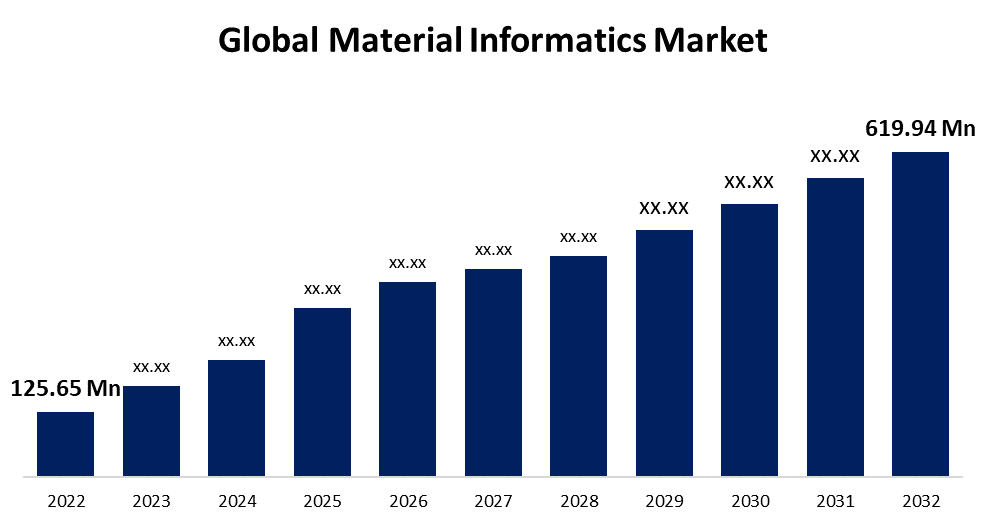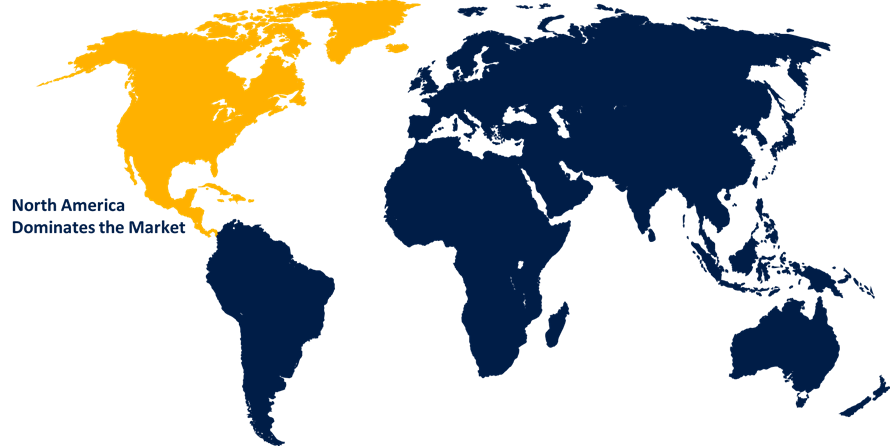Global Material Informatics Market Size, Share, and COVID-19 Impact Analysis, By Material Type (Elements and Chemicals), By Application (Chemical & Pharmaceutical, Materials Science, Manufacturing, Food Science, Energy, and Others), By Region (North America, Europe, Asia-Pacific, Latin America, Middle East, and Africa), Analysis and Forecast 2022 - 2032
Industry: Information & TechnologyGlobal Material Informatics Market Insights Forecasts to 2032
- The Global Material Informatics Market Size was valued at USD 125.65 Million in 2022.
- The Market is Growing at a CAGR of 17.3% from 2022 to 2032.
- The Worldwide Material Informatics Market Size is expected to reach USD 619.94 Million by 2032.
- Asia-Pacific is Estimated to Grow at the highest during the forecast period.

Get more details on this report -
The Global Material Informatics Market Size is expected to reach USD 619.94 Million by 2032, at a CAGR of 17.3% during the forecast period 2022 to 2032.
Market Overview
Material informatics, also known as materials informatics or materials data science, is an interdisciplinary field that combines materials science, computer science, and data science to accelerate the discovery, design, and development of new materials. It leverages advanced computational techniques, machine learning algorithms, and data analytics to analyze and predict the properties, performance, and behavior of materials. By harnessing large databases of materials data, including their structures, compositions, and properties, material informatics enables researchers to uncover hidden patterns, identify novel materials with desired properties, and optimize existing materials for specific applications. This data-driven approach reduces the time and cost associated with traditional trial-and-error methods in materials research, opening up new possibilities for breakthroughs in various sectors, including energy, electronics, healthcare, and manufacturing.
Report Coverage
This research report categorizes the market for material informatics market based on various segments and regions and forecasts revenue growth and analyzes trends in each submarket. The report analyses the key growth drivers, opportunities, and challenges influencing the material informatics market. Recent market developments and competitive strategies such as expansion, product launch, and development, partnership, merger, and acquisition have been included to draw the competitive landscape in the market. The report strategically identifies and profiles the key market players and analyses their core competencies in each sub-segments of the material informatics market.
Global Material Informatics Market Report Coverage
| Report Coverage | Details |
|---|---|
| Base Year: | 2022 |
| Market Size in 2022: | USD 125.65 Million |
| Forecast Period: | 2022-2032 |
| Forecast Period CAGR 2022-2032 : | 17.3% |
| 2032 Value Projection: | USD 619.94 Million |
| Historical Data for: | 2018-2021 |
| No. of Pages: | 200 |
| Tables, Charts & Figures: | 120 |
| Segments covered: | By Material Type, By Application, By Region. |
| Companies covered:: | Mat3ra, Schrodinger, Dassault Systemes, Citrine Informatics, Phaseshift Technologies, Exabyte.io, Alpine Electronics Inc., Nutonian Inc., Materials Zone Ltd., BASF, Kebotix, AI Materia. |
| Pitfalls & Challenges: | COVID-19 Empact, Challenge, Future, Growth, & Analysis |
Get more details on this report -
Driving Factors
The material informatics market is driven by several factors that contribute to its growth and adoption due to the increasing demand for advanced materials across various industries, such as automotive, aerospace, electronics, and healthcare, is a significant driver. Material informatics enables the discovery of new materials with enhanced properties and performance, addressing the evolving needs of these sectors. Additionally, the growing availability of big data and the advancements in computational power and machine learning algorithms are fueling the development of material informatics. The ability to process and analyze vast amounts of materials data efficiently and extract valuable insights is crucial in accelerating materials research. Furthermore, the rising emphasis on sustainability and the need for eco-friendly materials is driving the adoption of material informatics, as it enables the discovery of environmentally friendly alternatives. Overall, the drivers of the material informatics market converge to enhance materials research, accelerate innovation, and meet the demands of various industries.
Restraining Factors
While the material informatics market has significant growth potential, it also faces certain restraints. One of the key challenges is the availability and quality of data. Material informatics heavily relies on comprehensive and accurate materials databases, which may be limited or incomplete. Obtaining and curating high-quality data can be time-consuming and costly. Moreover, the interpretation and integration of diverse data sources pose challenges in ensuring consistency and reliability. Another restraint is the complex nature of materials science, which involves intricate relationships between composition, structure, and properties. Developing accurate predictive models that capture these complexities remains a challenge. Additionally, the adoption of material informatics requires expertise in both materials science and data science, creating a shortage of skilled professionals. Addressing these restraints is crucial to realizing the full potential of material informatics in accelerating materials discovery and development.
Market Segmentation
- In 2022, the element segment accounted for around 48.2% market share
On the basis of the material type, the global material informatics market is segmented into elements and chemicals. The element segment commands the largest share of the market for several reasons because elements are the fundamental building blocks of materials, making them essential in material informatics research and development. Elements exhibit unique chemical and physical properties that directly influence the characteristics and behavior of materials. Therefore, understanding the properties and interactions of elements is crucial in the design and optimization of new materials. Additionally, elements serve as the foundation for compositional variations in alloys and compounds, enabling the creation of materials with tailored properties. Furthermore, elements are abundant and widely available, allowing for diverse applications across industries. As a result, the element segment holds the largest share in the material informatics market, as it forms the basis for the exploration and discovery of new materials with desired properties and applications.
- In 2022, the manufacturing segment dominated with more than 29.4% market share
Based on application, the global material informatics market is segmented into chemical & pharmaceutical, materials science, manufacturing, food science, energy, and others. The manufacturing sector holds a dominant position in the material informatics market for several reasons because manufacturing industries, such as automotive, aerospace, electronics, and consumer goods, heavily rely on advanced materials to enhance product performance and functionality. Material informatics plays a crucial role in accelerating the discovery and development of such materials. By leveraging computational techniques and data analytics, material informatics enables manufacturers to analyze and predict material properties, optimize manufacturing processes, and design materials with desired characteristics. This data-driven approach helps in reducing costs, improving product quality, and shortening development cycles. Additionally, material informatics aids in the identification of sustainable and eco-friendly materials, aligning with the increasing focus on environmental regulations and consumer demands for greener products. The manufacturing sector's dependence on advanced materials and the benefits offered by material informatics positions it as a dominant application segment in the material informatics market.
Regional Segment Analysis of the Material Informatics Market
- North America (U.S., Canada, Mexico)
- Europe (Germany, France, U.K., Italy, Spain, Rest of Europe)
- Asia-Pacific (China, Japan, India, Rest of APAC)
- South America (Brazil and the Rest of South America)
- The Middle East and Africa (UAE, South Africa, Rest of MEA)
North America dominated the market with more than 30.5% revenue share in 2022.

Get more details on this report -
North America has emerged as the dominant player in the material informatics market for several reasons such as a robust ecosystem for scientific research and development, with renowned universities, national laboratories, and industrial collaborations. This ecosystem fosters innovation and attracts top talent in both materials science and data science. North America boasts a strong industrial base across various sectors, including aerospace, automotive, electronics, and energy, which drive the demand for advanced materials and the adoption of material informatics. Additionally, the region has been at the forefront of technological advancements, particularly in computational techniques and machine learning algorithms, which are essential for material informatics. Furthermore, favorable government initiatives and funding support for research and development further contribute to North America's dominance in the material informatics market. These factors collectively position North America as a leader in material informatics adoption and drive its market dominance.
Competitive Analysis:
The report offers the appropriate analysis of the key organizations/companies involved within the global material informatics market along with a comparative evaluation primarily based on their product offering, business overviews, geographic presence, enterprise strategies, segment market share, and SWOT analysis. The report also provides an elaborative analysis focusing on the current news and developments of the companies, which includes product development, innovations, joint ventures, partnerships, mergers & acquisitions, strategic alliances, and others. This allows for the evaluation of the overall competition within the market.
List of Companies:
- Mat3ra
- Schrodinger
- Dassault Systemes
- Citrine Informatics
- Phaseshift Technologies
- Exabyte.io
- Alpine Electronics Inc.
- Nutonian Inc.
- Materials Zone Ltd.
- BASF
- Kebotix
- AI Materia
Key Target Audience
- Market Players
- Investors
- End-Users
- Government Authorities
- Consulting and Research Firm
- Venture Capitalists
- Value-Added Resellers (VARs)
Recent Developments
- In January 2022, Schrodinger has completed the acquisition of XTAL BioStructures, Inc., a privately held company specializing in structural biology services. This strategic acquisition enhances Schrodinger's capacity to generate superior target structures for its drug discovery initiatives and broadens its service portfolio to encompass advanced and unique offerings, granting customers access to protein structures.
Market Segment
This study forecasts revenue at global, regional, and country levels from 2019 to 2032. Spherical Insights has segmented the global material informatics market based on the below-mentioned segments:
Material Informatics Market, By Material Type
- Elements
- Chemicals
Material Informatics Market, By Application
- Chemical & Pharmaceutical
- Materials Science
- Manufacturing
- Food Science
- Energy
- Others
Material Informatics Market, Regional Analysis
- North America
- US
- Canada
- Mexico
- Europe
- Germany
- UK
- France
- Italy
- Spain
- Russia
- Rest of Europe
- Asia Pacific
- China
- Japan
- India
- South Korea
- Australia
- Rest of Asia Pacific
- South America
- Brazil
- Argentina
- Rest of South America
- Middle East & Africa
- UAE
- Saudi Arabia
- Qatar
- South Africa
- Rest of Middle East & Africa
Need help to buy this report?